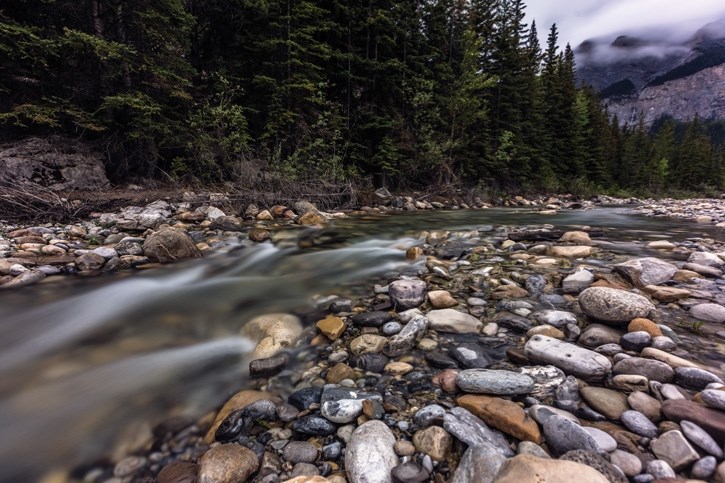BANFF – Once a wild and free river, waters are once again flowing in the Cascade almost to the Bow River.
In what is now called Cascade Creek, waters are running from the Minnewanka reservoir to Cascade Ponds, below the Trans-Canada Highway and beside the Legacy Trail east of Banff between the road and train tracks.
Parks Canada has been working with TransAlta to try to get bigger flows into the stretch of river below the Lake Minnewanka reservoir, reduced to a mere trickle over the decades compared to historical levels.
During the 2013 flood, the spillway was opened to release water from the reservoir for the first time in its 72-year history, turning the creek into a raging river once again as it followed the historic route of the Cascade – once a tributary of the Bow River.
Bill Hunt, resource conservation manager for Banff National Park, said most people aren’t aware that the ditch that runs along the south side of the Trans-Canada Highway, beside the Legacy Trail, is part of the Cascade.
“Before the 2013 flood it was actually a dry, grassy ditch, but the flood reaffirmed the river’s desire to be there,” he said.
“There’s now a nice little creek flowing year round.”
TransAlta’s Cascade hydro power plant is located on the Cascade River – the only power development in a Canadian national park. It’s part of the Bow River electric system, generating an average of 52,000-megawatt hours a year.
The Calgary-based power company bought the Cascade plant from the federal government in 1941. The following year, TransAlta built a new dam and power plant to replace the original.
When the Cascade plant was built, Lake Minnewanka was created as a storage reservoir and a four-kilometre canal carried water from the lake to the Cascade plant located along the Trans-Canada Highway.
But with that, the 5.5-kilometre middle stretch of the Cascade from below the dam to Cascade Ponds, referred to as Cascade Creek, became a small stream controlled by a riparian outflow valve at the southwest end of Lake Minnewanka.
Then, the middle section of the Cascade below the dam almost never connected with the downstream section, while the lower section from Cascade Ponds typically never reached the Bow River.
Historically, the Cascade circumvented Lake Minnewanka and drained an area of about 660 square kilometres, with its flows about 15 per cent of the volume of the Bow River.
With the dam controlling flows into the Cascade, flows to the historical channel below the dam had been reduced by 99 per cent.
Hunt said TransAlta last year replaced the old riparian valve, which has allowed for better control of the water flow, noting it is 0.5 cubic metres per second compared to the historic river flows of about eight cubic metres.
“That was a big job for TransAlta and allowed us to more control the water levels in a more timely way,” he said, noting the water flow was turned down for the past couple of years as Parks removed non-native fish.
“Then for about the last year they’ve turned water levels back up to a more regular base flow and we’ve just been waiting to see how it affects the overall water table. It varies a lot throughout the year.”
The current flows are inadequate to connect the creek system with the Bow River.
Once it flows beneath the CP culverts, the creek flows for another 100 to 200 metres before it disappears into an old gravel pit.
The long-term plan is to have it connect all the way to the Bow River, but first, Parks Canada has to work out a plan to keep non-native fish from making it from the Bow to the Cascade, where non-native brook trout have been removed.
Hunt said one possibility is looking at building a drop near the bottom of the reach where it joins the tailrace from the power plant.
“The whole section of Cascade Creek is free of non-native fish and we’d like to keep it that way,” he said.
“We’re looking at a drop that will allow native fish to go downstream, but not allow non-native fish to come up.”




